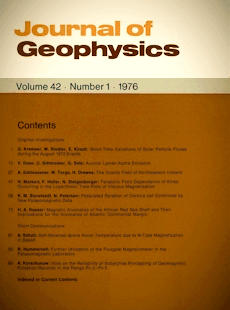Heat flow map of the Bohemian Massif
Article Sidebar
Published:
Apr 8, 1976
Keywords:
Geothermics,
Heat flow,
Bohemian Massif
Volumes

Vols. 1-18 (1924-1944), ISSN 0044-2801
Main Article Content
V. Čermak
Geophysical Institute, Czechoslovak Academy of Sciences, Prague, Czech Republic
Abstract
The heat flow pattern of the Bohemian Massif is presented by the compilation of 47 heat flow values. The isolines of the geothermal activity were constructed using also data in the neighbouring countries. A clear relationship between heat flow and the tectonic structure can be observed, higher geothermal activity corresponds to the zones of the weakened Earth's crust coinciding with two major deep faulted zones bordering the most rigid central part of the whole massif.
 ARK: https://n2t.net/ark:/88439/y053881
ARK: https://n2t.net/ark:/88439/y053881
Permalink: https://geophysicsjournal.com/article/195
Article Details
How to Cite
Section
References
Beranek, B., Dudek, A. (1972) The results of deep seismic sounding in Czechoslovakia. J. Geophys. 38:415-422
Čermak, V. (1967) Heat flow near Teplice in North Bohemia. Geophys. J. 13:547-549
Čermak, V. (1968) Terrestrial heat flow in Czechoslovakia and its relation to some geological features. 23. Inter. Geol. Congr., Prague 5:75-85
Čermak, V. 1975a() Temperature-depth profiles in Czechoslovakia and some adjacent areas derived from heat-flow measurements, deep seismic sounding and other geophysical data. Tectophysics 26:103-119
Čermak, V. (1975b) Terrestrial heat flow in the Neogene foredeep and the flysch zone of the Czechoslovak Carpathians. Geothermics 4:8-13
Čermak, V. (1976) First heat flow map of Czechoslovakia. Trav. Inst. Geophys. Tchecosl. Acad. Sci., Geofysikalni sbornik, Academia, Praha (In press)
Čermak, V., Jetel, J., Krčmar, B. (1968) Terrestrial heat flow in the Bohemian Massif and its relation to the deep structure. Sbornik geol. ved, UG :25-38
Haenel, R. (1971) Heat flow measurements and a first heat flow map of Germany. J. Geophys. 37:975-992
Haenel, R., Zoth, G. (1973) Heat flow measurements in Austria and heat flow maps of Central Europe. J. Geophys. 39:425-439
Hurtig, E., Schlosser, P. (1975) Untersuchungen des terrestrischen Warmeflusses in der DOR. Gerl. Beitr. Geoph. 84:235-246
Jetel, J. (1975) Perspektivy vyuziti zdroju geotermalni energie v CSR. Geol. pruzkum, 17:4-7
Kačura, G., Franko, O., Gazda, S., Šilar. J. (1969) Thermal and mineral waters of Czechoslovakia. 23. Inter. Geol. Congr. Prague, Proc. Symp. II, A:17-29
Kodym, O. (1960) Upper Palaeozoic of the Bohemian Massif. In: Zoubek, V. (Ed.) Tectonic Development of Czechoslovakia, Naki. CSA V, Praha, 122-138
Kopecky, L. (1972) Riftove struktury, fenity a mlady alkalicky magmatismus jako nositele rudni mineralisace v Českem masivu. Geol. pruzkum 14:195-198
Majorowicz, J. (1973) Heat flow in Poland and its relation to the geological structure. Geothermics 2:24-28
Matolin, M. (1970) Radioaktivita hornin Českeho masivu. Naki. ČSAV, Praha
Zoubek, V., Malkovsky, M. (1974) The Czechoslovakian part of the Bohemian Massif. In: Mahel, M. (Ed.) Tectonics of the Carpathian-Balkan Region, GUDŠ, Bratislava, 407-414
Čermak, V. (1967) Heat flow near Teplice in North Bohemia. Geophys. J. 13:547-549
Čermak, V. (1968) Terrestrial heat flow in Czechoslovakia and its relation to some geological features. 23. Inter. Geol. Congr., Prague 5:75-85
Čermak, V. 1975a() Temperature-depth profiles in Czechoslovakia and some adjacent areas derived from heat-flow measurements, deep seismic sounding and other geophysical data. Tectophysics 26:103-119
Čermak, V. (1975b) Terrestrial heat flow in the Neogene foredeep and the flysch zone of the Czechoslovak Carpathians. Geothermics 4:8-13
Čermak, V. (1976) First heat flow map of Czechoslovakia. Trav. Inst. Geophys. Tchecosl. Acad. Sci., Geofysikalni sbornik, Academia, Praha (In press)
Čermak, V., Jetel, J., Krčmar, B. (1968) Terrestrial heat flow in the Bohemian Massif and its relation to the deep structure. Sbornik geol. ved, UG :25-38
Haenel, R. (1971) Heat flow measurements and a first heat flow map of Germany. J. Geophys. 37:975-992
Haenel, R., Zoth, G. (1973) Heat flow measurements in Austria and heat flow maps of Central Europe. J. Geophys. 39:425-439
Hurtig, E., Schlosser, P. (1975) Untersuchungen des terrestrischen Warmeflusses in der DOR. Gerl. Beitr. Geoph. 84:235-246
Jetel, J. (1975) Perspektivy vyuziti zdroju geotermalni energie v CSR. Geol. pruzkum, 17:4-7
Kačura, G., Franko, O., Gazda, S., Šilar. J. (1969) Thermal and mineral waters of Czechoslovakia. 23. Inter. Geol. Congr. Prague, Proc. Symp. II, A:17-29
Kodym, O. (1960) Upper Palaeozoic of the Bohemian Massif. In: Zoubek, V. (Ed.) Tectonic Development of Czechoslovakia, Naki. CSA V, Praha, 122-138
Kopecky, L. (1972) Riftove struktury, fenity a mlady alkalicky magmatismus jako nositele rudni mineralisace v Českem masivu. Geol. pruzkum 14:195-198
Majorowicz, J. (1973) Heat flow in Poland and its relation to the geological structure. Geothermics 2:24-28
Matolin, M. (1970) Radioaktivita hornin Českeho masivu. Naki. ČSAV, Praha
Zoubek, V., Malkovsky, M. (1974) The Czechoslovakian part of the Bohemian Massif. In: Mahel, M. (Ed.) Tectonics of the Carpathian-Balkan Region, GUDŠ, Bratislava, 407-414











